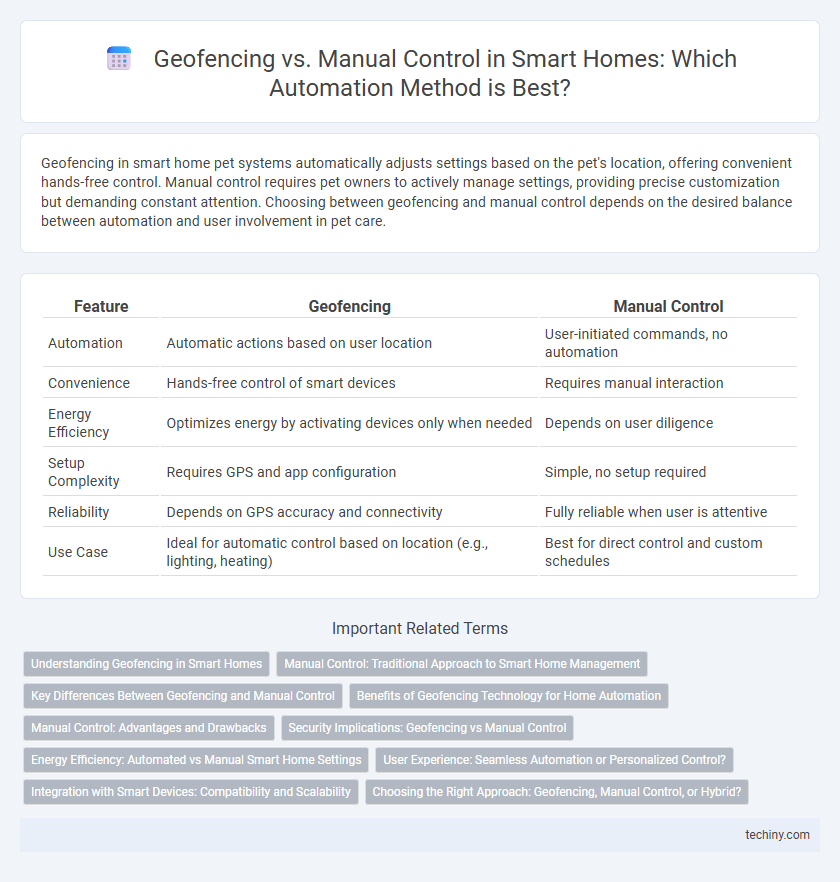Geofencing in smart home pet systems automatically adjusts settings based on the pet's location, offering convenient hands-free control. Manual control requires pet owners to actively manage settings, providing precise customization but demanding constant attention. Choosing between geofencing and manual control depends on the desired balance between automation and user involvement in pet care.
Table of Comparison
| Feature | Geofencing | Manual Control |
|---|---|---|
| Automation | Automatic actions based on user location | User-initiated commands, no automation |
| Convenience | Hands-free control of smart devices | Requires manual interaction |
| Energy Efficiency | Optimizes energy by activating devices only when needed | Depends on user diligence |
| Setup Complexity | Requires GPS and app configuration | Simple, no setup required |
| Reliability | Depends on GPS accuracy and connectivity | Fully reliable when user is attentive |
| Use Case | Ideal for automatic control based on location (e.g., lighting, heating) | Best for direct control and custom schedules |
Understanding Geofencing in Smart Homes
Geofencing in smart homes uses GPS or RFID technology to create virtual boundaries that automatically trigger specific actions when a homeowner's mobile device enters or leaves a defined area, enhancing convenience and security. Unlike manual control, which requires direct user input through apps or voice commands, geofencing enables seamless automation for lighting, climate, and security systems based on real-time location data. Integrating geofencing reduces energy consumption by adjusting settings dynamically, making smart homes more efficient and responsive to occupant behavior.
Manual Control: Traditional Approach to Smart Home Management
Manual control remains a fundamental approach in smart home management, allowing users direct interaction with devices through apps, remotes, or voice commands. This method provides precise customization and immediate response without reliance on location tracking or automation algorithms. Despite growing adoption of geofencing, manual control ensures user autonomy and consistent operation even in connectivity or GPS failures.
Key Differences Between Geofencing and Manual Control
Geofencing automates smart home devices by using GPS or RFID technology to trigger actions when a homeowner enters or leaves a predefined area, while manual control relies on direct user input via apps or voice commands. Geofencing offers hands-free convenience and energy efficiency by activating systems like lighting or thermostat based on location, whereas manual control provides precise and immediate adjustments but requires active participation. The key distinction lies in automation and proximity sensing in geofencing compared to user-initiated operation in manual control.
Benefits of Geofencing Technology for Home Automation
Geofencing technology in smart homes enables automatic control of devices based on the homeowner's location, enhancing convenience and energy efficiency. It reduces the need for manual input by triggering actions such as adjusting thermostats, unlocking doors, or turning lights on and off when entering or leaving a defined perimeter. This spatial automation improves security and optimizes energy consumption by ensuring appliances operate only when needed.
Manual Control: Advantages and Drawbacks
Manual control in smart home systems offers precise customization and immediate response to user commands, ensuring devices operate exactly as desired without reliance on location-based triggers. Advantages include greater user autonomy and the ability to manage devices in real time, which is essential when users are stationary or guests are present. Drawbacks involve potential inefficiency and inconvenience, as manual adjustments require continuous input, limiting automation's seamless convenience and energy-saving potential.
Security Implications: Geofencing vs Manual Control
Geofencing enhances smart home security by automatically activating alarms, locks, or lighting when residents leave or approach their property, reducing human error and delayed responses common in manual control systems. Manual control requires constant user vigilance, increasing the risk of forgotten security measures and potential breaches. Integrating geofencing with manual overrides offers optimal security by combining automated precision with user flexibility.
Energy Efficiency: Automated vs Manual Smart Home Settings
Geofencing technology optimizes energy efficiency by automatically adjusting smart home settings based on user location, reducing unnecessary power consumption when occupants are away. Manual control, while customizable, often results in inconsistent energy savings due to human error or forgetfulness. Automated systems leveraging geofencing create precise, real-time adjustments that enhance energy management compared to traditional manual methods.
User Experience: Seamless Automation or Personalized Control?
Geofencing offers seamless automation by using GPS or Wi-Fi signals to trigger smart home actions as users enter or leave predefined zones, enhancing convenience without user intervention. Manual control provides personalized adjustments through apps or voice commands, allowing users to tailor settings to their immediate preferences and needs. Combining geofencing with manual control creates an optimized user experience, balancing automated efficiency with customization flexibility.
Integration with Smart Devices: Compatibility and Scalability
Geofencing offers seamless integration with smart home devices by automatically adjusting settings based on user location, enhancing compatibility with various platforms like Alexa and Google Home. Manual control remains essential for personalized settings, allowing users to override automated actions and scale device interactions according to evolving needs. Both methods support scalability, but geofencing excels in dynamic environments where real-time responsiveness is crucial for efficient smart home management.
Choosing the Right Approach: Geofencing, Manual Control, or Hybrid?
Choosing the right approach between geofencing, manual control, or a hybrid system in smart home technology depends on user preferences for convenience, customization, and reliability. Geofencing automates actions based on location data, offering hands-free control ideal for dynamic lifestyles, while manual control provides precise user input for customized settings. Hybrid systems combine both methods, maximizing flexibility and ensuring seamless smart home management by leveraging automation alongside direct user commands.
Geofencing vs Manual Control Infographic

 techiny.com
techiny.com